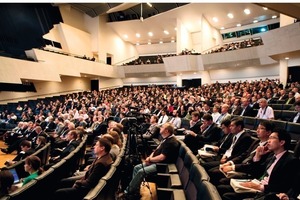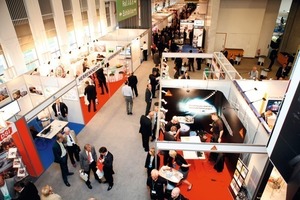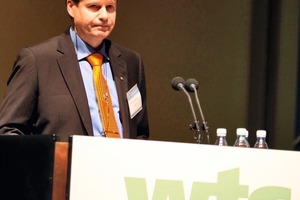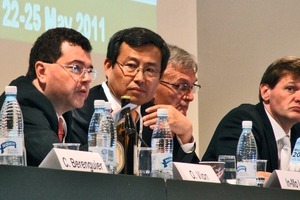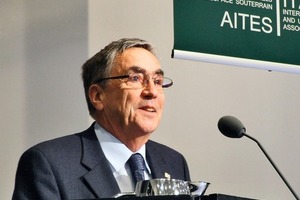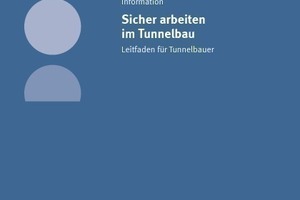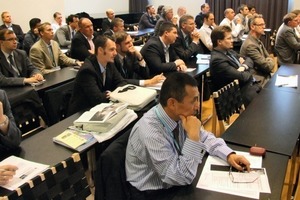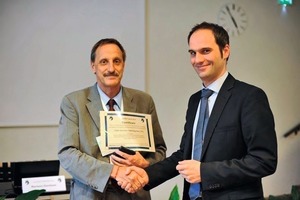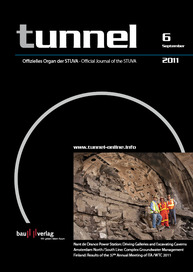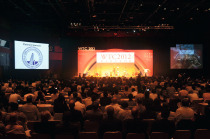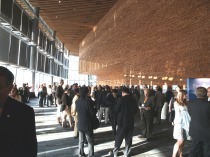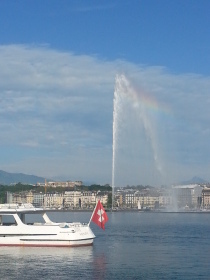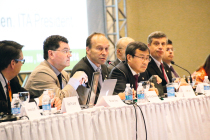37th Annual Meeting of the International Tunnelling and Underground Space Association – World Tunnel Congress 2011 in Helsinki, Finland
Every year tunnellers meet in a different member country somewhere in the world for their annual meeting and discuss the latest trends and developments. The following report provides an overview of the contents of the Congress, the results of the working groups (WGs) and further interesting news.
1 General
Approx. 1,400 tunnellers from 56 nations met in Helsinki, Finland from May 20 – 26, 2011 in Helsinki, Finland. The occasion: the 37th Annual Meeting of the ITA – International Tunnelling and Underground Space Association – in conjunction with the 2011 World Tunnel Congress. The Tunnel Congress staged by the Finnish Tunnelling Association and the Finnish Association of Civil Engineers (RIL) bore the motto “Underground Space in the Service of a Sustainable Society” (Fig. 1). 49 of the 64 member countries were represented in Helsinki. With a percentage of almost 77 % the number of countries represented was thus higher than the comparable values for previous years (roughly 70 %).
The following countries were represented: Argentina, Australia, Austria, Azerbaijan, Belarus, Belgium, Bosnia and Herzegovina, Brazil, Canada, Chile, China, Colombia, Republic of Korea, Croatia, Denmark, Egypt, Spain, United States of America, Finland, France, Germany, Greece, Hungary, India, Indonesia, Iran, Italy, Japan, Laos, Malaysia, Mexico, Montenegro, Nepal, Norway, The Netherlands, Poland, Portugal, Romania, United Kingdom, Russia, Singapore, Slovakia, Slovenia, South Africa, Sweden, Switzerland, Czech Republic, Thailand and Turkey.
The following ITA member countries were not represented in Helsinki:
Algeria, Saudi Arabia, Bulgaria, United Arab Emirates, Iceland, Israel, Kazakhstan, Lesotho, Morocco, Panama, Peru, Serbia, Ukraine, Venezuela and Vietnam.
2 World Tunnel Congress 2011
The Congress was prepared and organised by the Finnish Tunnelling Association in close collaboration with the ITA. The conference programme embraced 7 main themes and was presented at 24 technical sessions:
1. Planning the usage of subterranean spaces
2. Municipal services
3. Operational technologies
4. Traffic and logistics
5. Geologic disposal of nuclear waste
6. Renewable energy
7. Project management.
The contributions for the Conference programme were supplemented by various poster presentations and an accompanying exhibition (Fig. 2).
As in previous years a special ITA training course was held prior to the Congress proper on May 20 and 21. The 14 papers presented by experts from the academic and entrepreneurial fields were captioned “Conventional Rock Tunnelling and Sprayed Concrete Technology”. The training course comprised a theoretical and practical section. In the theoretical part international experts provided a comprehensive insight during more than 11 hours of lectures of the level of technology and knowledge relating to their specific fields. The main topics examined Rock Tunnelling: Excavation, Support and Design; Sprayed Concrete Technology; Reinforcements to Sprayed Concrete Linings. The 50 participants from 20 countries took an active part in the discussions thus underlining their great interest in the subject matter.
The practical demonstrations during the second part took place in an underground construction site, located directly under the venue “Finlandia Hall”. This year 4 sponsors provided their support and the demonstrations consisted of the following individual presentations: Best Spraying Practices (Normet), Sprayed Concrete Quality Control (VSH Hagerbach Test Gallery), Sprayable Membranes (MEYCO-BASF) and Fibre-reinforced Sprayed Concrete (MAPEI).
At the opening session on the Monday welcoming addresses were forthcoming from Helena Soimakallio (chairperson of the organising committee), Kari J. Korhonen (president of the Finnish Tunnelling Association FTA, Fig. 3) and In-Mo Lee (ITA president).
Subsequently the second lecture in memory of Sir Alan Muir-Wood was presented at this year’s WTC. In this “Muir-Wood Lecture” Prof. Robert Mair, Cambridge University (UK) examined “Tunnelling in urban Areas and Effects on Infrastructure – Advances in Research and Practice”.
In his lecture Mair provided an overview of how settlements and displacements resulting from a tunnel excavation can be calculated. In this connection he placed particular emphasis on the extent of damage buildings on the surface are subject to. In addition he reported on modern monitoring methods by means of which possible tendencies leading towards damage can be identified at an early stage. In this connection wireless techniques in particular indicate promise for the entire life cycle of a structure.
Then 3 high-quality keynote lectures were presented:
1. The Importance of Underground Spaces in the Underground Environment (Pekka Sauri, Deputy Mayor of City of Helsinki)
2. Rock Engineering and Tunnels – a Nordic Approach (Professor Håkan Stille, KTH – Royal Institute of Technology)
3. Disposal of spent Nuclear Fuel – From Plans to Reality in Finland (Timo Äikäs, Executive Vice President, Posiva Oy).
With his presentation Sauri provided an overview of existing and planned underground projects in the Finnish capital. Helsinki possesses – also on account of the stable rock – a relatively large number of underground facilities and has drawn up an “Underground Master Plan” for the future, in order to promote the use of underground space along the correct lines. Stille reported on the positive findings of tunnelling in rock and also on the associated risks. Äikäs followed up in his paper by looking at the problem of the final storage of nuclear waste, which has still to be resolved in many countries.
The ITA Open Session on the Tuesday was this year devoted to the topic of “Delivering better and more resilient Cities”.
The Open Session constituted part of the so-called “ITA Global Perspective” bearing the caption “Urban Underground Space in a Changing World”. In the course of this and the next 2 years the ITA will illuminate how underground spaces can contribute towards solving 2 urgent problems worldwide: the first of these is “Urbanisation” as pursued by the United Nations Human Settlements Programme (UN-HABITAT) and secondly “Making Cities resilient against natural Disasters and Effects of Climate Change”, which was passed by the United Nations International Strategy for Disaster Reduction, UN-ISDR. Towards this end one of the first objectives is to produce a document together with 3 global partner organisations constituting urban planners, city administrations and engineers (ISOCARP, ICLEI and IFME) for political decision-makers underlining the advantages of underground facilities.
Over the next 2 years the topics of the “ITA Global Perspective” will examine “Planning better and resilient Cities” in Bangkok in 2012 and “Deciding better and resilient Cities” in Geneva in 2013. All told the “ITA Global Perspective” consists of 7 activities:
1. Organising the 3 previously mentioned sessions through ITA-CUS (starting with the WTC in 2011); each of the sessions will be accompanied actively by one of the abovementioned organisations (2011 in Helsinki: IFME; 2012 in Bangkok: ISOCARP; 2013 in Geneva: ICLEI)
2. Active incorporation of working groups and member countries
3. Continuous cooperation with global partners (based on a corresponding agreement (MoU) as well as extended distribution of knowledge via congresses and workshops)
4. Producing a document for political decision-makers, which lays out the advantages of underground facilities; this paper is to be presented to UN HABITAT and UN ISDR
5. Providing grants to students (in conjunction with ITACET) in order to arrive at further results, as to how underground spaces can contribute to the abovementioned global topics
6. Further development of the ITA Global Perspective to become an initiative, which can rely on the involvement of internationally active companies.
7. Summit meetings should be held with urban decision-makers at yearly or half-yearly intervals in order to promote the “ITA Global Perspective” even further and to establish it as part of the commitment with the 2 UN organisations.
Within the ITA the relevant work is coordinated and undertaken by the Committee on Underground Space (ITA-CUS). When it was set up the Committee committed itself to increasing public awareness of the possibilities afforded by underground spaces and facilities.
Consequently the Open Session within the scope of the WTC ’11 was opened and presented by Han Admiraal, chairman of ITA-CUS. Following an introductory speech by ITA president In-Mo Lee and Dan-Henrik Långström, president of FAME and representative of IFME, the Deputy Mayor for City Planning, City of Helsinki, Finland Hannu Penttilä presented an opening lecture on “Helsinki Metropolitan Area: Vision 2050 and how to make it real”.
Various aspects of underground spaces were followed up on during the enduing podium discussion involving the audience. At the end of the debate a memorandum of understanding was signed with the International Federation for Municipal Engineering (IFME).
During the second part of the session the topics were enhanced by presentations from Jacques Besner, Canada, consultant for the planning of underground facilities and former secretary-general of ACUUS, Tetsuya Hanamura, emeritus professor at the University of Okayama, Japan and member of the ITA-CUS steering committee as well as from Andis Kublacovs, City of Riga, Latvia and head of the “Riga Northern Transport Corridor” project. During the podium discussion that followed the various aspects were once again dealt with. There was general agreement reached on the main points – last but not least as all those taking part in the discussion adopted a positive approach to underground construction.
3 General Assembly
President In-Mo Lee, Korea (Fig. 4) chaired the general assembly. At the beginning of the assembly secretary-general Claude Berenguier paid tribute to Victor Roisin, who died on January 11, 2011. Roisin was for many years chairman of the Belgian National Tunnelling Committee BTUS and a STUVA Executive Committee member from 1979 till 1992.
Subsequently Lee informed the delegates about membership developments. The number of member countries had risen by 6 to reach 64 since the previous year. New member countries are: Azerbaijan, Belarus, Nepal, Panama, Serbia and United Arab Emirates. Furthermore 15 corporative and 5 individual new members were welcomed. As a result the ITA now has 64 member nations, 187 corporative and 123 individual members making allowances for those who have bowed out.
Alterations to the statutes and the rules of procedure of the ITA represented an important point on the agenda. For example the function of the association’s general-secretary was abolished. In future his responsibilities will be taken over by the president and his duties transferred to the executive director. As far as membership is concerned clarification ensued regarding the role of the Executive Council members, the various kinds of members (corporative, individual and honorary) as well as prime sponsors and patrons. Furthermore the rules for the different elections were tightened up. This revision process was also applied to standardise various terms and harmonise the English and French versions.
As in previous years the members were informed about the means of communication used by the ITA and their development: the ITA Newsletter “Tribune” which has only been published once a year since 2005 focused on tunnelling in Finland in the 2010 issue. Furthermore it contains reports on activities of ITA member states as well as company profiles of ITA prime sponsors and patrons.
Five issues of the “ita@news” have been published since the 2010 General Assembly in Vancouver (Canada) and sent by e-mail. Thus altogether 39 times the latest news from the ITA, its working groups, the member countries, on future conferences relating to tunnelling, exhibitions, workshops and seminars as well as indications about the activities of international sister organisations have been published. The distribution of “ita@news” now embraces some 8,000 persons, companies, architectural offices and other organisations. The ITA Secretariat is interested in obtaining a feedback from regular readers.
The ITA scientific organ, the journal “Tunnelling and Underground Space Technology (TUST)” is now only accessible to ITA members in electronic form – albeit it contains the entire archives. In 2010 (year 25) 6 issues were published containing a total of just over 800 pages. In 2010 (year 26) so far a further 5 issues embracing around 650 pages have been brought out.
The ITA Website is visited by around 5,800 users per month from 130 different countries with the average session amounting to over 10 min. In addition to publicly available pages there is also a password-protected area for the internal exchange of data. Additionally there is a newly developed part of the Website, which is intended for decision-makers and the general public. Information on utilisation and planning of underground facilities is provided here as well as their specific advantages.
As in previous years, the report on the activities of the various ITA Working Groups (WGs) occupied a substantial amount of the General Assembly’s time. The pertinent details are provided in Chapter 5.
The General Assembly decided on the venue for the 2014 Annual Meeting. The cities of Sao Paulo (Brazil) and Sydney (Australia) and Singapore (Singapore) had applied. In the first round no candidate attained the necessary absolute majority from among the 48 member countries present or voting by proxy (18 votes for Sao Paulo, 8 for Sydney and 22 for Singapore). In the second round of voting the delegates then narrowly decided in favour of Sao Paulo as the venue (26 votes; Singapore 22 votes). In this connection the dates and venues for the following annual meetings are surely of interest:
• May 18 to 23, 2012, 38th ITA Annual Meeting in Bangkok, Thailand: with the motto “Tunnelling and Underground Spaces for a global Society”
• May 31 to June 5, 2013, 39th ITA Annual Meeting in Geneva (Switzerland) captioned: “Underground – the Way to the Future” (the date originally proposed has since been amended).
• May 9 to 15, 2014, 40th ITA Annual Meeting in Sao Paulo (Brazil); the topic: “Tunnels for better Living”.
At the end of the General Assembly the long-standing ITA secretary-general, Claude Berenguier stepped down after his final period of tenure (Fig. 5). Prof. Alfred Haack, ITA president from 1999 till 2001, recalled his joint term with Berenguier and referred to the most important milestones in Berenguier’s professional life. Berenguier, born 1942 in St. Etienne to the west of Lyon (France), commenced his career in 1965 after studying construction engineering at the ENTPE (Ecole Nationale des Travaux Publics de L’Etat, Vauix-en-Velin, to the east of Lyon) at CETU (Centre d’Etudes des Tunnels, Bron/Lyon). From there he switched for 3 years to the Ministry for Economics and International Affairs in Paris before returning to the ENTPE for a 6 year period. Subsequently Berenguier worked from 1989 till 1992 for SETRA, a state institute for highways and a further 4 years for CETE Méditerranée, an office for infrastructures in the Mediterranean region. He was on the payroll of CODATU, an association for the development and improvement of urban and underground infrastructures from 1996 till 2000. Then from 2000 till 2002 he was with CNAM, the French institute for technical science, before he retired after 36 years as a civil servant.
His activities with the ITA began back in 1975 with the first ITA General Assembly in Munich, which he took part in as the secretary of the PIARC (World Road Association). He was selected to become the secretary-general of the ITA at its 1987 General Assembly in Melbourne and filled this post for all of 25 years. He contributed a great deal towards the development f the ITA and collaborated with no less than 9 presidents: 1987 till 1989 Einar Broch (NO), 1990 till 1992 Colin Kirkland (UK), 1993 till 1995 Dan Eisenstein (CA), 1996 till 1998 Sebastiano Pellizza (IT), 1999 till 2001 Alfred Haack (DE), 2002 till 2004 Andre Assis (BR), 2005 till 2007 Harvey Parker (US), 2008 till 2010 Martin Knights (UK) and 2011 till 2013 In-Mo Lee (KR). His diplomatic finesse, his ability to find the right words, his love of travel, his interest in alien cultures as well as his ability to master critical situations with humour were often of help to the ITA. The Executive Council and the General Assembly would like to thank Claude Berenguier for his many years’ involvement and wish him and his wife Nan all the best for the future.
4 ITA Executive Council (EC)
All members of the EC were elected for 3 years or confirmed in office as well as nominated for new tasks at the 2010 General Assembly. As a result no elections took place in 2011. Francois Vuilleumier, Switzerland, was elected as treasurer until 2010 and has stepped down from the EC in the meantime. His duties have been taken over by Felix Amberg, who was elected in 2010. The ITA Executive Council is thus still made up as follows:
I.-M. Lee, Korea,
president till 2013
M. Knights,
UK, past-president till 2013
M. Thewes, Germany,
1st vice-president till 2013
B. Yun, China,
vice-president till 2013
S. Eskesen, Denmark,
vice-president till 2013
J. Hrdina, Czech Republic,
vice-president till 2013
A. Elioff, USA (till 2013)
P. Kocsonya, Hungary (till 2013)
R. P. Lovat, Canada (till 2013)
C. N. Ow, Singapore (till 2913)
D. Peila, Italy (till 2013)
F. Amberg, Switzerland,
treasurer till 2013
The General Assembly re-appointed S. Calinescu, Romania, as internal auditor for a further year. Pekka Särkkä, Finland, was represented in the EC on behalf of the host country Finland for the 2011 WTC but will accordingly step down after the event. Vince Suwansawat, Thailand, Felix Amberg, Switzerland and Tarcisio Celestino, Brazil are at the EC’s disposal for the World Tunnel Congresses in 2012, 2013 and 2014 respectively. Olivier Vion, appointed executive director of the ITA on Jan. 1, 2009, also backs up the Executive Council.
In the interim the following activities have been defined within the EC:
a) Technical Affairs: Thewes, Elioff and Peila
b) General Affairs: Eskesen, Ow and Kocsonya
c) Sponsor and Industry Relations: Hrdina and Lovat
d) Member Nation Development and Coordination: Bai South-East Asia: Ow and Wagner (external experts)
Russia and Neighbouring Countries: Lovat and Belenkey (external experts)
e) Communication: Knights.
In addition the following persons will support the EC in special matters:
• Andre Assis and Piergiorgio Grasso: Development of the Associations in South America
• Harvey Parker: Relations with United Nations
• Eivind Grov: Relations with Industry and ITA-TECH
• Yann Leblais: Working Group 11 Tutor.
5 Activities of the Working Groups and Committees
The ITA Executive Council decided to promote the activities of the Working Groups (WGs) more strongly as they contribute decisively to the ITA’s image in the world outside. Collaboration between persons from different countries is accomplished in the WGs in particular thus encouraging an important exchange of experiences. As a result the ITA Secretariat will support the WGs by means of active back-up, the application of a web meeting tool, an improved web document management system and shorter peer review cycles. Furthermore an attempt will be made e. g. through the increased deployment of students to relieve those heading the WGs. In future the WG animateur will provide his report to the EC as a single-page format to simplify matters.
In Helsinki 12 of the active ITA working groups met to continue their technical discussions. The animateurs of the WGs reported to the General Assembly on May 25, 2011 on the stage reached by their work and the activities scheduled for the months ahead.
Working Group 2: Research
Animateur: Eric Leca, France; vice-animateur: Chung-Sik Yoo, Korea; Tutor: Søren Eskesen, Denmark
14 experts from 12 countries took part in the consultations.
The current draft of the document on “Monitoring and Control for Tunnelling Projects” compiled by the WG, which takes into account both reflections put forward by members of the WG as well as comments from the ITA Executive Council, was discussed. The final draft was scheduled for completion in June 2011. The recommendations for the “Strategy for Site Investigations of Underground Works” are being jointly processed with the ISRM. The current draft was scrutinised and updated during the session. A new version is also to be made available by the end of June 2011.
With regard to risk management the deliberations honed in on “Terminology”. Based on work by AFTES an opening section for the “Guideline on Tunnelling Risk Management” is to be compiled.
In addition a presentation on current developments for high-strength concretes was put forward. A paper is also to be drafted on this topic in order to further foster its development.
For the future the subject of “Sustainability in Tunnelling” was selected. A sub-WG was set up to collect and scrutinise relevant data from ITA member countries.
Working Group 3: Contractual Practices in Underground Construction
Animateur: Arnold Dix, Australia; vice-animateur: Martin Smith, UK; tutor: Martin Knights, UK
19 experts from 13 countries participated in the session as well as 3 external guests: Enrico Vink (executive director of the FIDIC), Robert Gerrard (NEC3) and a representative of the Swiss Engineers and Architects Association SIA.
The ITA Report No. 6 captioned Contractual Framework Checklist for Subsurface Construction Contracts has been published. This document contains important pointers for drafting construction contracts in order to assure that the project objectives for all those involved are arrived at under the fairest possible conditions.
As a next step contracts, which were drafted in keeping with various contractual patterns (e.g. FIDIC, NEC3 or SIA) are to be perused and compared with findings derived from actual contracts. An initial draft is to be tabled at the WG session in 2012, which is to be passed on to the ITA Executive Council 1 year later following a subsequent revision.
Working Group 5: Health and Safety in Tunnelling
Animateur: Donald Lamont, UK; vice-animateur: Martin Vogel, Switzerland; tutor: Ivan Hrdina, Czech Republic
The 7 delegates attending from 7 countries have now completed the revision of the booklet “Safety in Tunnelling”, which was undertaken with the financial support of the BG Bau (Fig. 6). The final version has in the meantime been passed on to the ITA Executive Council to be scrutinised. In addition recommendations for working in compressed air “Guidelines for good Working Practice in high-pressure Compressed Air” have been drafted. The current draft is to be tabled to both the British Tunnelling Society as well as the ITA Executive Council for scrutiny. Furthermore safety recommendations for shaft construction work are being drafted in close collaboration with the South African National Committee on Tunnelling (SANCOT).
Working Group 6: Maintenance and Repair of Underground Structures
Animateur: Henry Russell, USA; vice-animateur: René van den Bosch, Netherlands; tutor: Bai Yun, China
Experts from 6 countries took part in the discussions.
The WG’s consultations centred on guidelines for “Structural Fire Protection for Metro Tunnels”. This document represents an important follow-up to the corresponding guidelines on road tunnels, which has already been published by the WG. It was determined that future activities would concern the application of fire-extinguishing systems in road tunnels as well as ingressing groundwater during operation and corresponding renovation by means of grouting,
Working Group 9: Seismic Effects
Animateur: Wenge Qiu, China, vice-animateur: Gary Kramer, Canada; tutor Daniele Peila, Italy
In Helsinki 8 experts from 5 countries took part in this working group’s discussions.
Firstly the revision of 2 previously completed reports was discussed. The one relates to “Aseismic Design of Underground Structures”, 1987 and the second to “Seismic Design and Analysis on Underground Structures”, 2001. Furthermore the list of damage to tunnels caused by seismic activity was augmented with the effects of the earthquakes in Wenchuan (China, 2008) and Miyagi (Japan, 2011).
It was also decided to compile new guidelines, which focus particularly on seismic safety of urban underground structures, the safety of shallow tunnels, the safety of especially long tunnels at great depth or the safety of tunnels in active fault zones. Towards this end first of all existing guidelines, norms and regulations principally from ITA member countries as well as publications by experts are to be collected. An initial draft of this document is scheduled for 2013.
Working Group 11: Immersed and Floating Tunnels
Animateur: Christian Ingerslev, USA; vice-animateur; Jonathan Baber, UK; tutor: Yann Leblais, France
24 experts from 8 countries attended the deliberations of this WG. First of all an overview of 13 new projects was provided, which led to a lively discussion on the special production technologies.
Since the last session the first parts of an “Owners’ Guide” for immersed tunnels has been compiled: in addition to the introduction the first 6 of 40 aspects have been prepared to such an extent that they have been able to be published on the ITA Website.
On 5 and 6 October, 2010 a 2-day course was held in Abu Dhabi in conjunction with ITACET captioned “”Design and Construction of Immersed Tunnels”. Furthermore in October 2010 at the International Symposium on Archimedes Bridge in China (ISAB-2010) a keynote lecture on “Immersed and Floating Tunnels” was held.
For the future the compilation of a report on the environmental aspects of immersed and floating tunnels is foreseen. In addition to this updating of the list of projects is to be pursued and the abovementioned guide for owners augmented by a further 14 chapters. Furthermore a short presentation on immersed and floating tunnels is scheduled for the next congress.
Working Group 12: Shotcrete Use
Animateur: Atsumu Ishida, Japan; vice-animateur: Odd-Bjorn Kleven, Norway; tutor: Felix Amberg, Switzerland
23 experts from 14 countries took part in the WG’s deliberations.
Ongoing and future activities were up for discussion. In this connection the initial draft of an ITA Report on fibre-reinforced shotcrete was debated. Its completion is scheduled for after the 2012 General Assembly. Furthermore a paper on the durability of shotcrete and the relevant quality assurance tests was distributed and the WG’s members were requested to augment it. A sub-WG was also formed, which will concentrate on sprayable sealing systems. As far as the certification of nozzle operators is concerned the “level of technology” in various countries has been appraised in the interim and cooperation with ITACET and EFNARC decided upon.
Working Group 14: Mechanisation of Excavation
Animateur: Lars Babendererde, Germany; vice-animateur: Felix Amberg, Switzerland; tutor: Katsuji Fukumoto: Japan
The compilation of outstanding projects, which strikingly display the opportunities afforded by mechanised drives, was once again augmented by current projects. In conjunction with improving collaboration among the individual WGs pointers for the applicability of various tunnelling technologies are to be provided in a joint document “Key Issues in Tunnelling”. Work on this document is on-going.
Working Group 15: Underground Works and the Environment
Animateur: Jan Rohde, Norway; vice-animateur: Yoshikazu Ota, Japan; tutor: Amanda Elioff (USA)
Six experts from 6 countries participated in the consultations in Helsinki.
The objectives to be pursued during the years ahead were defined at the beginning of the session. The main aim is to compile an international synthesis report on environmental effects – regardless of whether useful of harmful – which tunnelling exercises on the environment. Towards this end case examples will be applied to indicate which effects special projects had on the environment and climatic protection in the member country as well as supraregionally. In addition a list of corresponding projects in the member countries will continue to be compiled. These activities are expected to be concluded in 2012 and the final draft of the report in 2013.
Working Group 17: Long Tunnels at great Depth
Animateur: Gérard Seingre, Switzerland; vice-animateur: Jenny Yan, China; tutor: Piergorgio Grasso, Italy
The WG session was attended by 10 representatives from 10 countries. First of all Jenny Yan (China) was appointed vice-animateur of the Working Group to succeed Minoru Shimokawachi (Japan).
After the WG had completed the ITA Report 4 “Long Tunnels at Great Depth” prior to the WTC in Vancouver, it concentrated on prioritising future activities. Firstly a White Book on the financing of mega projects is to be compiled. The intention is to have it published in the course of 2012. Furthermore a report on access galleries and shafts is to be published by 2013.
Working Group 19: Conventional Tunnelling
Animateur: Heinz Ehrbar, Switzerland; vice-animateur: Robert Galler, Austria; tutor: Markus Thewes, Germany
Altogether 13 participants from 11 countries attended this WG’s deliberations. Two lectures were presented at the beginning of the session: one dealing with the subway in San Francisco captioned “Traditional Practices of Conventional Tunnelling in Urban Environment in the United States” and a second relating to comparing Design-Bid-Build (DBB) and Design-Build (DB) contracts.
WG 19’s main task still concerns the compilation of a document relating to special contractual aspects of conventional tunnelling. The second draft was tabled at the session and discussed intensively. It is intended to ensure that the guide has been completed to such an extent by the time of the next session in Bangkok that it can be tabled to the Executive Council.
Following up last year’s discussions it is planned to compile a joint document featuring tunnelling methods. The related activities are due to start in 2012.
Working Group 20: Urban Problems – Underground Solutions
Animateur: Wout Broere, Netherlands; vice-animateur: currently vacant; tutor: Pàl Kocsonya, Hungary
19 experts from 13 countries participated in this WG’s deliberations.
The WG has been able to register good progress in drawing up an overview relating to typical challenges faced by urban planning and the related available solutions provided by underground space. The final draft of the report captioned “Urban Problems – Underground Solutions” was approved by the WG at the session.
Further emphasis was laid on the collation of case examples, which lay out the advantage of underground facilities. In this connection focus is directed on the influence of the underground infrastructure on tangible values as well as the provision of a solid basis for cost-benefit analysis.
ITA-CET – Committee on Education and Training
The Committee on Education and Training (ITA-CET) has met twice since the 2010 General Assembly in Vancouver. Altogether 18 training courses have so far been offered, including one in French and an online training course at the University of Texas. The topics were for example: conventional tunnelling, mechanised tunnelling, shotcrete, sealing, risk management, safety and health, use of underground spaces, monitoring and operation, immersed and floating tunnels, supply tunnels in cities, tunnel design and innovations in tunnelling. These activities are in close cooperation with the ITACET Foundation.
ITACET Foundation
The establishment of a “Foundation for Education and Training on Tunnelling and Underground Space Use” (ITACET) decided on by the member countries at the 2009 General Assembly was implemented on Sept. 25, 2009. The foundation serves the administrative and financial execution of educational and training measures. Its main objective is to promote education for persons involved in tunnelling especially in threshold countries.
The Foundation Council has met twice since the 2010 WTC. Within the first full year since its inception the Secretariat was first set up in close collaboration with the ITA and the Website (ww.itacet.org) placed online. Furthermore 7 newsletters have been dispatched so far. All told 18 training programmes have so far been prepared in conjunction with the ITA-CET Committee as well as an expert data bank established.
The following training courses were held following the WTC ’10: Immersed and Floating Tunnels (Abu Dhabi, October 2010), Construction Methods (Buenos Aires, October 2010), Design Principles (Bangkok, November 2010 and Kuala Lumpur, February 2011) as well as Shotcrete (Helsinki 2011 – WTC 2011). Between 40 and 160 persons took part at the various courses. Altogether since the ITACET was set up around 700 persons have attended training courses. In addition the following courses are at the concrete planning stage: Numerical Methods (Hagenberg, Austria, July 2011), Operational Safety (Shanghai, China, November 2011), Tunnelling (Phnom Penh, Cambodia, December 2011) as well as Urban Tunnelling (Bangkok, Thailand, May 2012 – WTC 2012).
Generally speaking it is intended to sponsor events for threshold countries financially as well as to sign framework agreements with the ITA member countries and the tunnelling industry.
ITA-COSUF – Committee on Operational Safety of Underground Facilities
Animateur: Didier Lacroix, France; tutor: Felix Amberg, Switzerland
The Committee on Operational Safety of Underground Facilities (ITA-COSUF) currently has 71 members from 23 countries. COSUF is intended as a centre of competence for the worldwide exchange of expert knowledge and information relating to safety in underground facilities. The 4 activity groups form the core of the committee:
• AG 1: interaction with European and international activities
• AG 2: Regulation and best Practice
• AG 3: Research and new Findings
• AG 4: European Forum of Road Tunnel Safety Officers.
Shortly after the 2010 WTC in Vancouver the COSUF General Assembly was held in Frankfurt on June 8, 2010 together with a workshop on “Risk Assessment – The State of the Art Approach to deal with Safety in Underground Facilities”. The proceedings are available on CD. A further internal workshop was held in Stockholm on October 19 + 20, 2010 entitled “City Tunnel in Stockholm – Means for efficient and safe Transportation”.
The annual General Assembly held in conjunction with the WTC in Helsinki on May 23, 2011 was again coupled with an open workshop, at which 11 papers were presented. The workshop bore the caption “Designing Underground Safety – How far to go?” (Fig. 7). The presentations and discussions were devoted to the following topics:
• Hazardous Incidents
• Impacts and Loads
• Simulation, Validation and Mitigation Measures
• Experience gained when putting into Reality.
The numerous participants took an active part in the discussions, for which a large time frame was deliberately made available. The presentations have in the meantime been sent to the participants on CD and can be made available to COSUF members on request.
The animateur and the heads of the various AGs reported on the past year’s activities at the General Assembly and provided an insight of the activities planned for the coming year.
At his own request the incumbent animateur Felix Amberg stepped down so that the General Assembly adopted the proposal by the steering group and chose Didier Lacroix as the new animateur. Felix Amberg will in future be available to COSUF as tutor.
The “Prize for Outstanding Work in the COSUF Working Sector” for 2010 was awarded to Stefan Kratzmeir from Germany within the scope of the workshop for his activities in the field of Tunnel Fire Protection by Water Mist Systems (Fig. 8).
ITA-CUS – Committee on Underground Space
The Committee on Underground Space regards its task to be that of encouraging the public to become more aware of the possibilities afforded by underground space and facilities. With this goal in mind ITA-CUS staged the 2011 WTC open session. There have already been lengthy reports concerning this and the objectives of ITA-CUS.
ITA-TECH – Committee on Technologies and Development
At this year’s General Assembly the representatives of the member nations decided to establish a new committee for “Technologies and Development”. This committee is intended to provide the suppliers and manufacturers represented in the ITA with a platform to be able to improve technologies and industrial developments in a targeted manner. The aim is to promote new and improved construction technologies as well sustainable developments for underground spaces.
ITA-TECH is foreseen as a forum at which topics on underground construction are discussed openly thus allowing conclusions to be turned into practice. Technological developments in particular are to be lent impetus in order to master the challenges set by the tunnelling industry. These challenges include for example the demand to reduce risks, major time pressure during projects, required cost efficiency, extended safety standards as well as the lack of well trained technical staff.
The ITA-TECH has concrete aims:
• Developing ideas and concepts for new and improved technologies for underground construction
• Establishing technical guidelines and recommendations as the basis for future standards
• Early recognition of trends on the market and in the branch
• Coming up with a mutual understanding for new technologies as the basis for rapid transformation into marketable products
• Providing a backdrop for active exchange of technical information on a regular basis between suppliers, contractors and planners
• Formulating arguments from the viewpoint of industry (prime sponsors) for political decision-makers.
Both experts from the various companies as well as the entire branch profit from accomplishing these objectives through improving the acceptance of underground construction.
ITA-TECH intends setting up a total of 8 activity groups, with the first 7 oriented towards the processes involved in underground construction and a further group generally engaged with designing tunnels:
• Exploration
• Excavation
• Lining (temporary support)
• Inner lining and sealing
• Installation and technical furnishing for operation
• Supervision and monitoring
• Maintenance and redevelopment
• Design (concerning all previously mentioned processes).
The activity groups are geared to collecting information, compiling reports, evolving concepts, working out guidelines and recommendations, initiating research projects as well as formulating the required training programmes.
6 Publications and Information
Further details of the World Tunnel Congress and the ITA General Assembly 2011 in Helsinki as well as the most important resolutions passed at the General Assembly and the activities of the working groups are published on the webpage www.ita-aites.org, in the ita@news (can be subscribed free-of-charge via www.ita-aites.org) as well as in the Proceedings and the USB stick issued in conjunction with the World Tunnel Congress.
Further information relating to the ITA and future annual meetings is available from:
The Secretariat of the German Committee for Underground Construction Inc. (DAUB), Mathias-Brüggen-Str. 41, D-50827 Cologne (www.daub-ita.de) or the Secretariat of the ITA – International Tunnelling and Underground Space Association (c/o EPFL), GC D 1 402 (Bât. GC), Station 18, CH-1015 Lausanne (www.ita-aites.org) as well as the secretariats of the national tunnel associations of the various ITA member countries.

